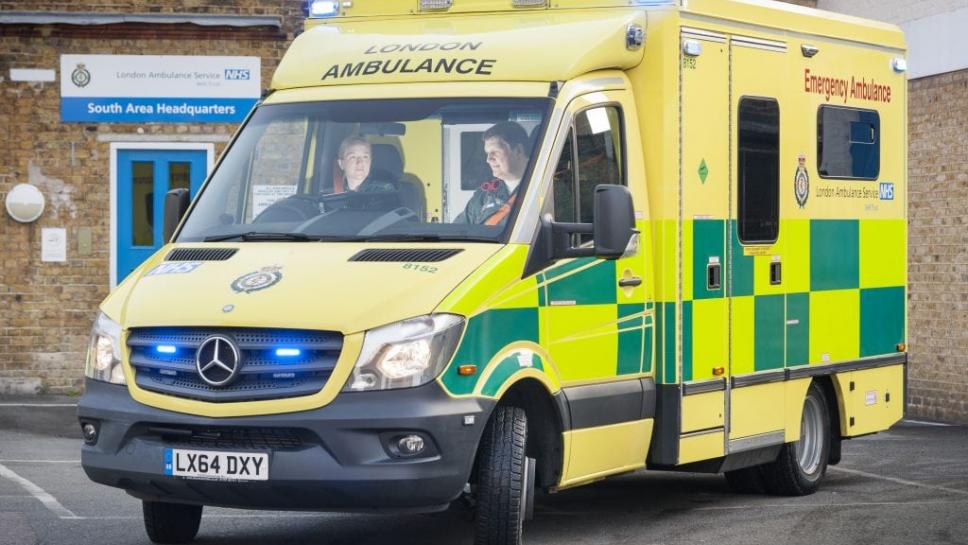
Last week NHS England data revealed that thousands of people were left waiting in ambulances to be seen by staff at A&E as hospitals struggled to manage demand for treatment.
Muscular Dystrophy UK is taking action to support paramedics to provide the best possible emergency care for people with neuromuscular conditions.
Our ‘Ambulance Action’ campaign aims to encourage ambulance trusts across the UK to set up a flagging system that alerts paramedics and first responders that the person they are treating has a neuromuscular condition and allows them to access individualised care plans before they arrive on the scene.
Muscular Dystrophy UK has already worked with the London Ambulance Service to set up a flagging system and by June 2018 we are aiming to ensure that similar systems have been introduced in as many as three more regions of the UK.
To reach this target we have written to ambulance trust Chief Executives across the UK to discuss how Muscular Dystrophy UK can support their services to improve emergency care for people with neuromuscular conditions. Currently, we have meetings arranged with representatives of three ambulance services and plan to meet with all trusts this year.
We will also be launching a report on this issue alongside ambulance and NHS services at a meeting of the All-Party Parliamentary Group for Muscular Dystrophy later in 2018.
As part of our campaign we have been speaking to people affected by muscle-wasting conditions to gather their experiences of emergency care, whose stories are shared below:
Suzanne Glover from County Down, Northern Ireland, has Spinal Muscular Atrophy (SMA) and reflects on her first experience of emergency care:
If it's possible to reflect on such a scary time of poor health as positive, my ambulance and emergency care was excellent. The paramedics took time to assess my current respiratory difficulties as well as take note of my chest infection history and SMA.
I carry an 'oxygen alert' with me at all times to make medical professionals aware that I should be supported with non-invasive ventilation as opposed to direct oxygen. This information was carefully taken on board and passed on to the Emergency Department before my arrival.
I feel that there is huge lack of awareness of SMA in Emergency Care. Without family being beside my bed explaining the condition and the normal course of treatment, I would have become ill a lot faster.
I would not fault the health care professionals in their ability listen and understand what my family explain to them. But in the ideal world, this information should be know already by first response professionals to quicken up the admission and treatment.
Wayne Lenson from Cornwall, who has Emery-Dreifuss muscular dystrophy, describes his extensive experience of emergency care:
I have been taken to hospital around 45ish times over the past 5 years by ambulance. The reason for this is that I experience severe chest pains caused by the tightening of my muscles in my chest.
Annoyingly they share many of the same symptoms as a heart attack which is why I have been taken into hospital with it so much. And the excruciating pain that goes with it of course.
My experience of the ambulance service has been extremely positive in terms of the care that I have received and the arrival time considering I live in a rural area.
Their general knowledge of muscle wasting conditions seems good however when I mention muscular dystrophy the only type they seem to really know about is Duchenne. Although they are usually very interested in the condition and are keen to gain information.
Update: Following a successful meeting with the South East Coast Ambulance Service this week we’re delighted to announce that we will be working with the trust and the Lane Fox Respiratory Unit at Guys and St Thomas’ NHS Foundation Trust to ensure their patients access best-practice emergency care.
Neuromuscular clinicians at Lane Fox will receive training to allow them to add patients’ care plans directly on to the South East Coast Ambulance Service’s flagging system. This will make it easier for clinicians to enable paramedics to access neuromuscular care plans before they arrive on the scene.
Following this initial pilot with Lane Fox, training will be provided to all specialist neuromuscular clinicians with patients in the South East Coast. This will ensure all patients who could benefit from being flagged to the ambulance service will be added to the system.
Muscular Dystrophy UK has also collaborated with a range of specialist health professionals to create condition-specific alert cards for different muscle-wasting conditions which allow patients and their families to easily inform paramedic teams of the vital and specific issues which affect their care.
Since the launch of these cards we have sent out over 12,000 to people living with muscle-wasting conditions and health professionals.
If you would like to share your experience of emergency care, or would like us to send you an alert card, then get in touch with campaigns@musculardystrophyuk.org.
